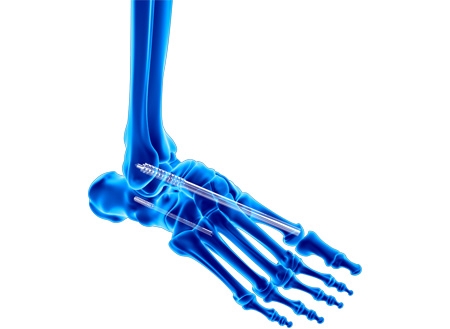Of all the chronic conditions that affect the foot and ankle, Charcot foot may be considered one of the more severe. If not caught early, limited options for treatment exist. Charcot foot is a condition that affects people with peripheral neuropathy, or decreased sensation in the extremities. People with diabetes are at an increased risk of developing a Charcot foot due to the neuropathy that often accompanies this disease. The lack of feeling causes injuries to go unnoticed and untreated. Over time, the bones, tendons, and ligaments in the foot and ankle become increasingly weakened and no longer hold their shape and stability. The result is a rather grossly deformed foot and ankle that can lead to other problems as well.
You may be thinking to yourself, "But why don't people notice that their foot is becoming increasingly deformed? Isn't it painful?" The tricky part about neuropathy is that the decreased sensation is typically significant and results in injuries going unnoticed. Fractures, sprains, joint dislocations, wounds, and the general deterioration of the musculoskeletal structure can indeedgo unnoticed for a length of time.
In the beginning stages of Charcot foot, the foot is usually found to be red, warm, and swollen. X-rays will identify any fracture or dislocation present. Typically, a physical exam by one of our board-certified orthopaedic physicians will also diagnose any soft tissue injury resulting in laxity of a joint. If identified at this initial stage, treatment options exist to mitigate the risk of developing further deformity. Immobilization using a cast, pneumatic walking boot, brace, or customized orthosis is warranted both to prevent further injury and to allow the damaged tissue to heal. These items are usually paired with a non-weight bearing status for a duration of time to further allow the area to heal and regain stability. Supplementation in the form of calcium or vitamin D may also be recommended to help promote bone healing.
Once significant deformity is present, the condition cannot be reversed and is much harder to treat. Sometimes, a gauntlet ankle brace is recommended to provide general stability over the ankle. Sores often develop as well because of how the now deformed foot sits in a shoe. Appropriate footwear designed to fit the shape of the foot and help prevent further deformity from taking place as well as prevent sores from opening on the skin is important. Sores associated with Charcot foot are particularly problematic because they have a higher risk of developing an infection. Ultimately, an untreated wound with associated infection can lead to amputation of the extremity.
The severity of the deformity can vary greatly. Sometimes only the ankle joint is involved. In other instances, the deformity is widespread from the ankle into the midfoot and becomes quite debilitating.. If you have neuropathy, keep a close eye on those feet. If you notice any abnormalities in appearance whether than be color, skin integrity, or structural abnormality, see a physician right away. Our goal at OAW is to keep you on your fully functioning feet as best we can! Check us out at any one of our three clinic locations: Pewaukee, Mukwonago, or Brookfield!
This blog is written by one of our very own-Morgan. She is a certified athletic trainer working in our clinic with our providers each and every day. She obtained a bachelor's degree in athletic training from Carroll University in Waukesha and a master's degree in Kinesiology from Michigan State University.

